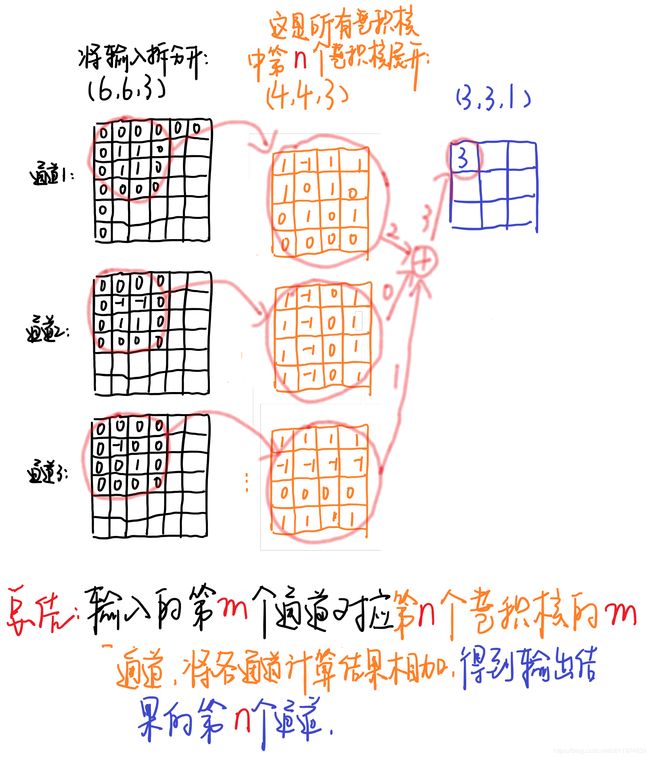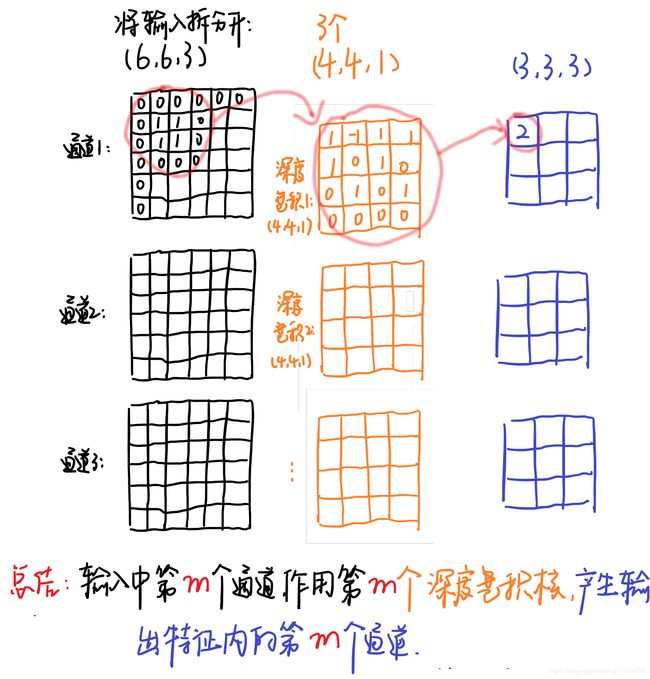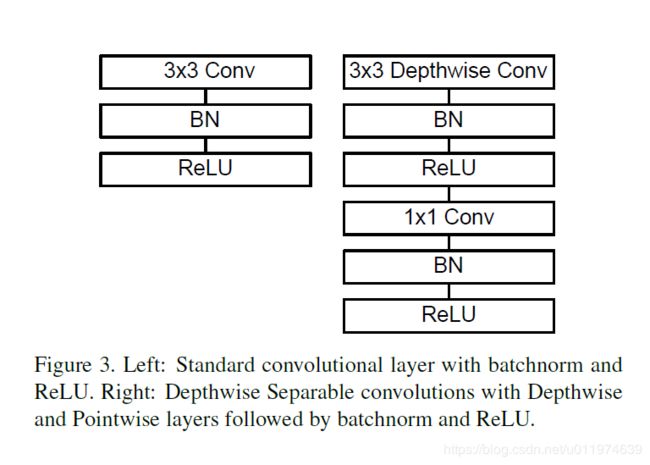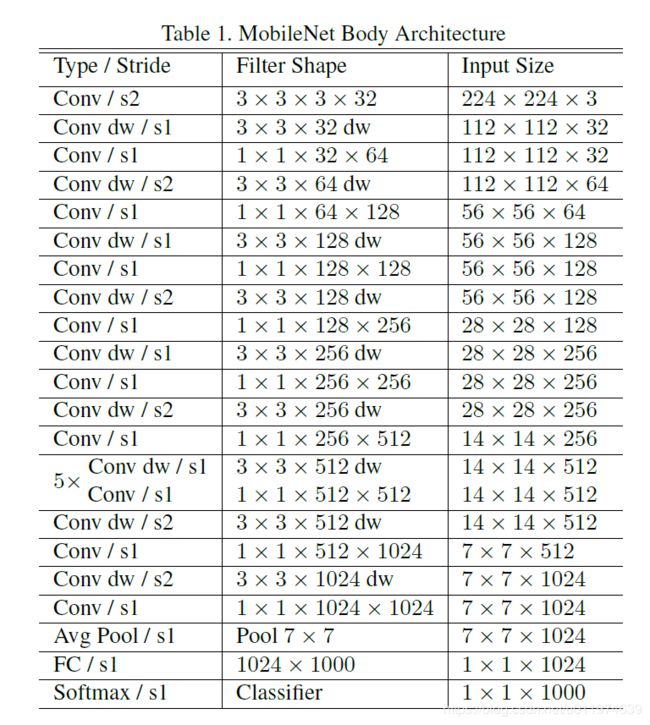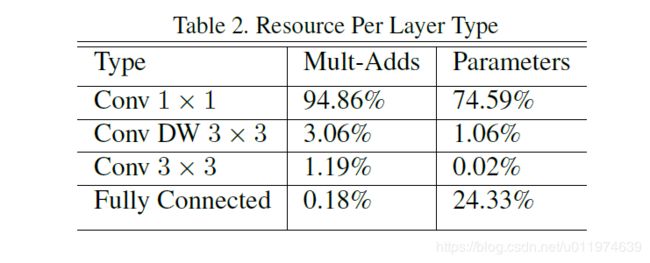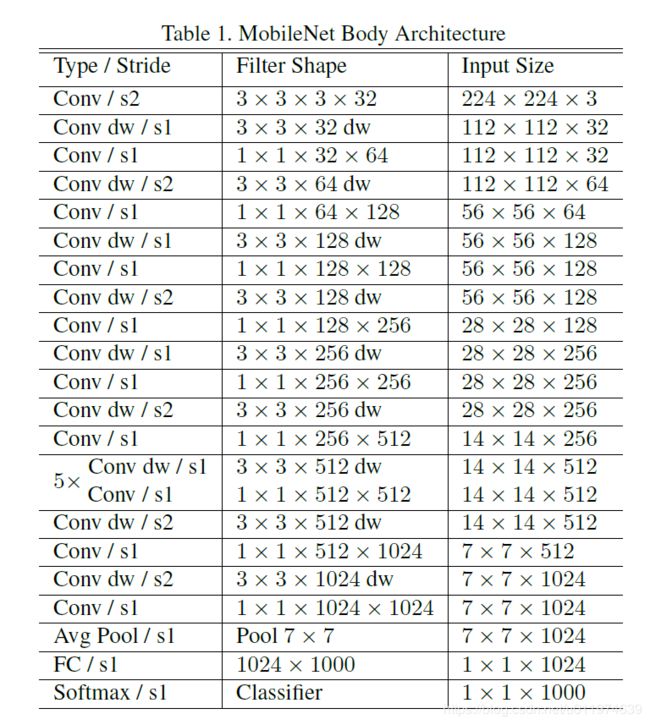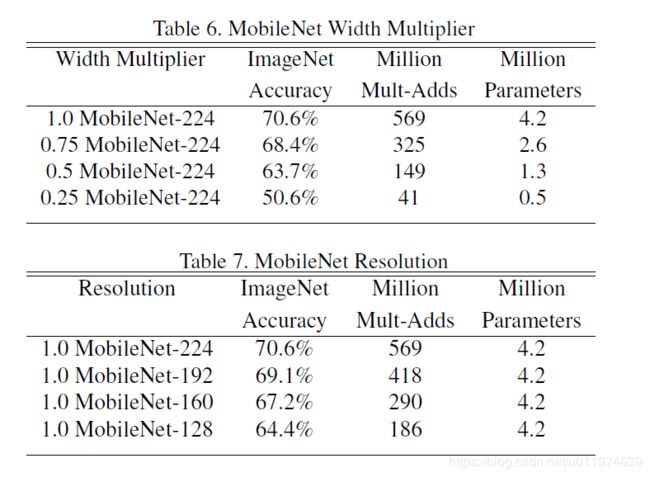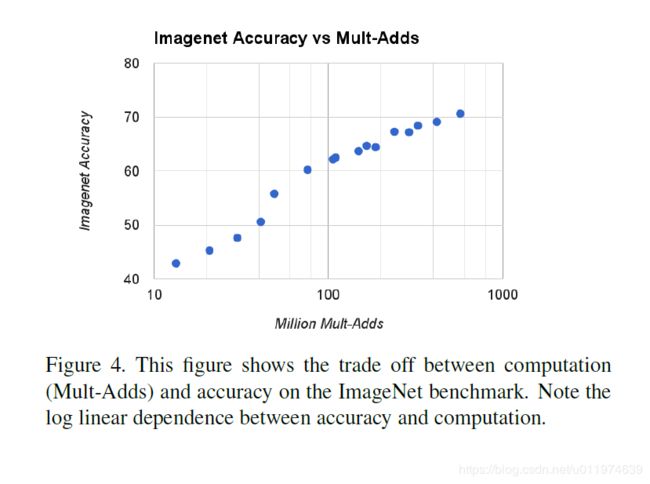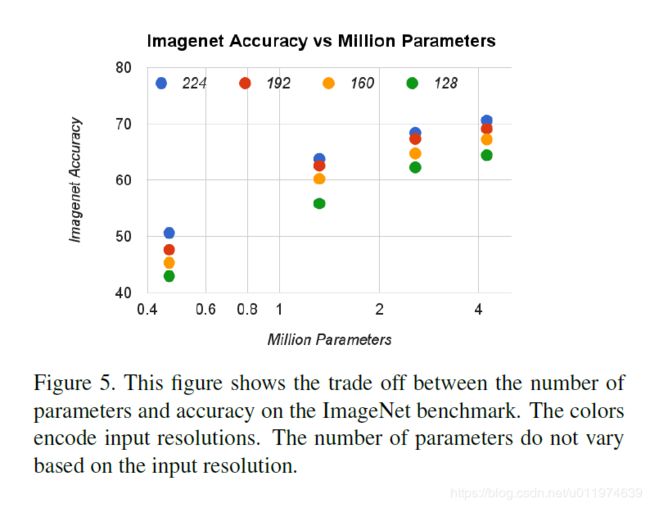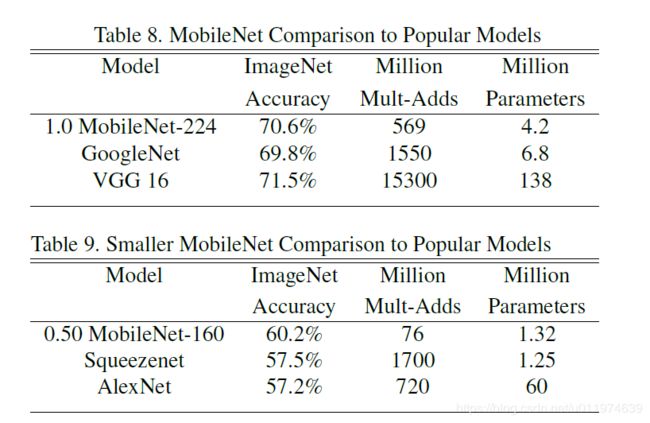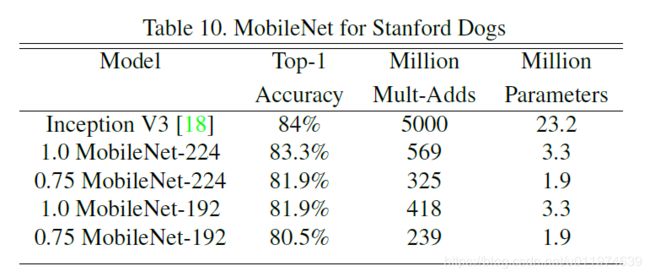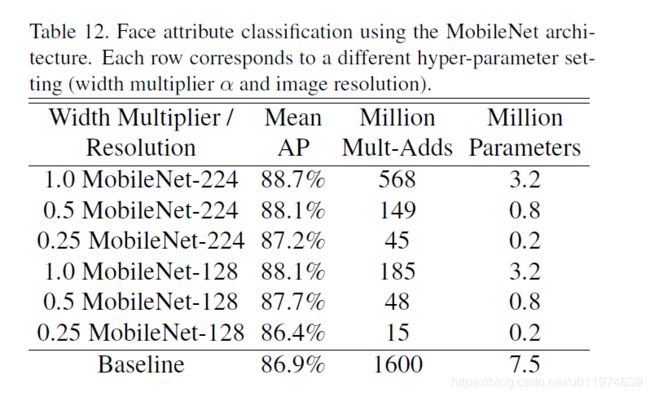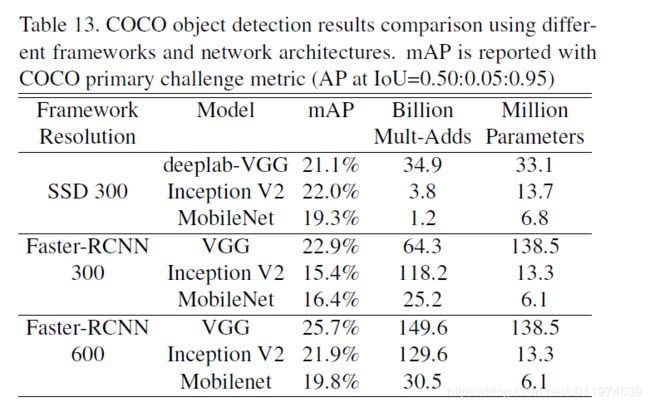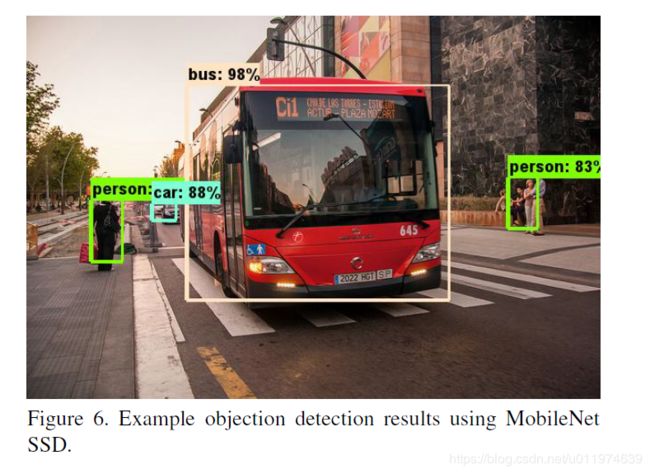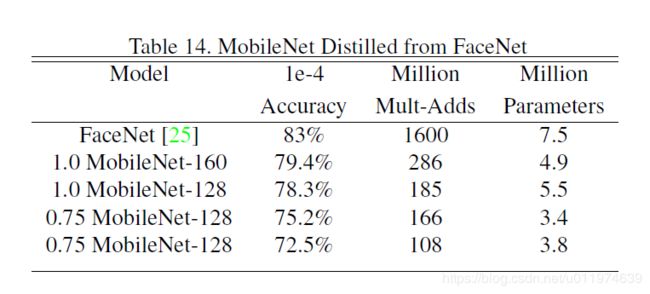轻量级网络--MobileNet、Shufflenet
原文地址: https://blog.csdn.net/u011974639/article/details/79199306
https://blog.csdn.net/u011974639/article/details/79200559
MobileNets: Efficient Convolutional Neural Networks for Mobile Vision Applications
原文地址:MobileNetV1
代码:
- TensorFlow官方
- github-Tensorflow
- github-Caffe
Abstract
MobileNets是为移动和嵌入式设备提出的高效模型。MobileNets基于流线型架构(streamlined),使用深度可分离卷积(depthwise separable convolutions,即Xception变体结构)来构建轻量级深度神经网络。
论文介绍了两个简单的全局超参数,可有效的在延迟和准确率之间做折中。这些超参数允许我们依据约束条件选择合适大小的模型。论文测试在多个参数量下做了广泛的实验,并在ImageNet分类任务上与其他先进模型做了对比,显示了强大的性能。论文验证了模型在其他领域(对象检测,人脸识别,大规模地理定位等)使用的有效性。
Introduction
深度卷积神经网络将多个计算机视觉任务性能提升到了一个新高度,总体的趋势是为了达到更高的准确性构建了更深更复杂的网络,但是这些网络在尺度和速度上不一定满足移动设备要求。MobileNet描述了一个高效的网络架构,允许通过两个超参数直接构建非常小、低延迟、易满足嵌入式设备要求的模型。
Related Work
现阶段,在建立小型高效的神经网络工作中,通常可分为两类工作:
-
**压缩预训练模型。**获得小型网络的一个办法是减小、分解或压缩预训练网络,例如量化压缩(product quantization)、哈希(hashing )、剪枝(pruning)、矢量编码( vector quantization)和霍夫曼编码(Huffman coding)等;此外还有各种分解因子(various factorizations )用来加速预训练网络;还有一种训练小型网络的方法叫蒸馏(distillation ),使用大型网络指导小型网络,这是对论文的方法做了一个补充,后续有介绍补充。
-
直接训练小型模型。 例如Flattened networks利用完全的因式分解的卷积网络构建模型,显示出完全分解网络的潜力;Factorized Networks引入了类似的分解卷积以及拓扑连接的使用;Xception network显示了如何扩展深度可分离卷积到Inception V3 networks;Squeezenet 使用一个bottleneck用于构建小型网络。
本文提出的MobileNet网络架构,允许模型开发人员专门选择与其资源限制(延迟、大小)匹配的小型模型,MobileNets主要注重于优化延迟同时考虑小型网络,从深度可分离卷积的角度重新构建模型。
Architecture
Depthwise Separable Convolution
MobileNet是基于深度可分离卷积的。通俗的来说,深度可分离卷积干的活是:把标准卷积分解成深度卷积(depthwise convolution)和逐点卷积(pointwise convolution)。这么做的好处是可以大幅度降低参数量和计算量。分解过程示意图如下:
输入的特征映射 F F F FFF FFF尺寸为 ( D F , D F , M ) ( D F , D F , M ) ( D F , D F , M ) (DF,DF,M)(D_F,D_F,M)(DF,DF,M) (DF,DF,M)(DF,DF,M)(DF,DF,M),采用的标准卷积 K K K KKK KKK为 ( D K , D K , M , N ) ( D K , D K , M , N ) ( D K , D K , M , N ) (DK,DK,M,N)(D_K,D_K,M,N)(DK,DK,M,N) (DK,DK,M,N)(DK,DK,M,N)(DK,DK,M,N)(如图(a)所示),输出的特征映射为 G G G GGG GGG尺寸为 ( D G , D G , N ) ( D G , D G , N ) ( D G , D G , N ) (DG,DG,N)(D_G,D_G,N)(DG,DG,N) (DG,DG,N)(DG,DG,N)(DG,DG,N)
标准卷积的卷积计算公式为: G k , l , n = ∑ i , j , m K i , j , m , n ⋅ F k + i − 1 , l + j − 1 , m G k , l , n = ∑ i , j , m K i , j , m , n ⋅ F k + i − 1 , l + j − 1 , m G k , l , n = i , j , m ∑ K i , j , m , n ⋅ F k + i − 1 , l + j − 1 , m Gk,l,n=∑i,j,mKi,j,m,n⋅Fk+i−1,l+j−1,mG_{k,l,n}=\sum_{i,j,m}K_{i,j,m,n}·F_{k+i-1,l+j-1,m}Gk,l,n=i,j,m∑Ki,j,m,n⋅Fk+i−1,l+j−1,m Gk,l,n=∑i,j,mKi,j,m,n⋅Fk+i−1,l+j−1,mGk,l,n=i,j,m∑Ki,j,m,n⋅Fk+i−1,l+j−1,mGk,l,n=i,j,m∑Ki,j,m,n⋅Fk+i−1,l+j−1,m 输入的通道数为 M M M MMM MMM,输出的通道数为 N N N NNN NNN。对应的计算量为: D K ⋅ D K ⋅ M ⋅ N ⋅ D F ⋅ D F D K ⋅ D K ⋅ M ⋅ N ⋅ D F ⋅ D F D K ⋅ D K ⋅ M ⋅ N ⋅ D F ⋅ D F DK⋅DK⋅M⋅N⋅DF⋅DFD_K·D_K·M·N·D_F·D_FDK⋅DK⋅M⋅N⋅DF⋅DF DK⋅DK⋅M⋅N⋅DF⋅DFDK⋅DK⋅M⋅N⋅DF⋅DFDK⋅DK⋅M⋅N⋅DF⋅DF
可将标准卷积 ( D K , D K , M , N ) ( D K , D K , M , N ) ( D K , D K , M , N ) (DK,DK,M,N)(D_K,D_K,M,N)(DK,DK,M,N) (DK,DK,M,N)(DK,DK,M,N)(DK,DK,M,N)拆分为深度卷积和逐点卷积:
- 深度卷积负责滤波作用,尺寸为 ( D K , D K , 1 , M ) ( D K , D K , 1 , M ) ( D K , D K , 1 , M ) (DK,DK,1,M)(D_K,D_K,1,M)(DK,DK,1,M) (DK,DK,1,M)(DK,DK,1,M)(DK,DK,1,M)如图(b)所示。输出特征为 ( D G , D G , M ) ( D G , D G , M ) ( D G , D G , M ) (DG,DG,M)(D_G,D_G,M)(DG,DG,M) (DG,DG,M)(DG,DG,M)(DG,DG,M)
- 逐点卷积负责转换通道,尺寸为 ( 1 , 1 , M , N ) ( 1 , 1 , M , N ) ( 1 , 1 , M , N ) (1,1,M,N)(1,1,M,N)(1,1,M,N) (1,1,M,N)(1,1,M,N)(1,1,M,N)如图©所示。得到最终输出为 ( D G , D G , N ) ( D G , D G , N ) ( D G , D G , N ) (DG,DG,N)(D_G,D_G,N)(DG,DG,N) (DG,DG,N)(DG,DG,N)(DG,DG,N)
深度卷积的卷积公式为: G k , l , n = ∑ i , j K i , j , m ⋅ F k + i − 1 , l + j − 1 , m G ^ k , l , n = ∑ i , j K ^ i , j , m ⋅ F k + i − 1 , l + j − 1 , m G k , l , n = i , j ∑ K i , j , m ⋅ F k + i − 1 , l + j − 1 , m G^k,l,n=∑i,jK^i,j,m⋅Fk+i−1,l+j−1,m\hat{G}_{k,l,n}=\sum_{i,j}\hat{K}_{i,j,m}·F_{k+i-1,l+j-1,m}G^k,l,n=i,j∑K^i,j,m⋅Fk+i−1,l+j−1,m Gk,l,n=∑i,jKi,j,m⋅Fk+i−1,l+j−1,mG^k,l,n=i,j∑K^i,j,m⋅Fk+i−1,l+j−1,mGk,l,n=i,j∑Ki,j,m⋅Fk+i−1,l+j−1,m其中KaTeX parse error: Got function '\hat' with no arguments as superscript at position 2: K^̲\hat{K}K^是深度卷积,卷积核为 ( D K , D K , 1 , M ) ( D K , D K , 1 , M ) ( D K , D K , 1 , M ) (DK,DK,1,M)(D_K,D_K,1,M)(DK,DK,1,M) (DK,DK,1,M)(DK,DK,1,M)(DK,DK,1,M),其中 m t h m t h m t h mthm_{th}mth mthmthmth个卷积核应用在 F F F FFF FFF中第 m t h m t h m t h mthm_{th}mth mthmthmth个通道上,产生KaTeX parse error: Got function '\hat' with no arguments as superscript at position 2: G^̲\hat{G}G^上第 m t h m t h m t h mthm_{th}mth mthmthmth个通道输出.
深度卷积和逐点卷积计算量:$D_K·D_K·M·D_F·D_F + M·N·D_F·D_F $
计算量减少了: D K ⋅ D K ⋅ M ⋅ D F ⋅ D F + M ⋅ N ⋅ D F ⋅ D F D K ⋅ D K ⋅ M ⋅ N ⋅ D F ⋅ D F = 1 N + 1 D K 2 D K ⋅ D K ⋅ M ⋅ D F ⋅ D F + M ⋅ N ⋅ D F ⋅ D F D K ⋅ D K ⋅ M ⋅ N ⋅ D F ⋅ D F = 1 N + 1 D K 2 D K ⋅ D K ⋅ M ⋅ N ⋅ D F ⋅ D F D K ⋅ D K ⋅ M ⋅ D F ⋅ D F + M ⋅ N ⋅ D F ⋅ D F = N 1 + D K 2 1 DK⋅DK⋅M⋅DF⋅DF+M⋅N⋅DF⋅DFDK⋅DK⋅M⋅N⋅DF⋅DF=1N+1DK2\frac{D_K·D_K·M·D_F·D_F + M·N·D_F·D_F }{D_K·D_K·M·N·D_F·D_F}=\frac{1}{N} + \frac{1}{D_K^2}DK⋅DK⋅M⋅N⋅DF⋅DFDK⋅DK⋅M⋅DF⋅DF+M⋅N⋅DF⋅DF=N1+DK21 DK⋅DK⋅M⋅DF⋅DF+M⋅N⋅DF⋅DFDK⋅DK⋅M⋅N⋅DF⋅DF=1N+1DK2DK⋅DK⋅M⋅N⋅DF⋅DFDK⋅DK⋅M⋅DF⋅DF+M⋅N⋅DF⋅DF=N1+DK21DK⋅DK⋅M⋅N⋅DF⋅DFDK⋅DK⋅M⋅DF⋅DF+M⋅N⋅DF⋅DF=N1+DK21
深度分类卷积示例
输入图片的大小为 ( 6 , 6 , 3 ) ( 6 , 6 , 3 ) ( 6 , 6 , 3 ) (6,6,3)(6,6,3)(6,6,3) (6,6,3)(6,6,3)(6,6,3),原卷积操作是用 ( 4 , 4 , 3 , 5 ) ( 4 , 4 , 3 , 5 ) ( 4 , 4 , 3 , 5 ) (4,4,3,5)(4,4,3,5)(4,4,3,5) (4,4,3,5)(4,4,3,5)(4,4,3,5)的卷积( 4 × 44 × 44 × 4 4×44×44×4 4×44×44×4是卷积核大小,3是卷积核通道数,5个卷积核数量),stride=1,无padding。输出的特征尺寸为 6 − 41 + 1 = 3 6 − 4 1 + 1 = 316 − 4 + 1 = 3 6−41+1=3\frac{6-4}{1}+1=316−4+1=3 6−41+1=316−4+1=316−4+1=3,即输出的特征映射为 ( 3 , 3 , 5 ) ( 3 , 3 , 5 ) ( 3 , 3 , 5 ) (3,3,5)(3,3,5)(3,3,5) (3,3,5)(3,3,5)(3,3,5)
将标准卷积中选取序号为 n n n nnn nnn的卷积核,大小为 ( 4 , 4 , 3 ) ( 4 , 4 , 3 ) ( 4 , 4 , 3 ) (4,4,3)(4,4,3)(4,4,3) (4,4,3)(4,4,3)(4,4,3),标准卷积过程示意图如下(注意省略了偏置单元):
黑色的输入为 ( 6 , 6 , 3 ) ( 6 , 6 , 3 ) ( 6 , 6 , 3 ) (6,6,3)(6,6,3)(6,6,3) (6,6,3)(6,6,3)(6,6,3)与第 n n n nnn nnn个卷积核对应,每个通道对应每个卷积核通道卷积得到输出,最终输出为 2 + 0 + 1 = 32 + 0 + 1 = 32 + 0 + 1 = 3 2+0+1=32+0+1=32+0+1=3 2+0+1=32+0+1=32+0+1=3。(这是常见的卷积操作,注意这里卷积核要和输入的通道数相同,即图中表示的3个通道~)
对于深度分离卷积,把标准卷积 ( 4 , 4 , 3 , 5 ) ( 4 , 4 , 3 , 5 ) ( 4 , 4 , 3 , 5 ) (4,4,3,5)(4,4,3,5)(4,4,3,5) (4,4,3,5)(4,4,3,5)(4,4,3,5)分解为:
- 深度卷积部分:大小为 ( 4 , 4 , 1 , 3 ) ( 4 , 4 , 1 , 3 ) ( 4 , 4 , 1 , 3 ) (4,4,1,3)(4,4,1,3)(4,4,1,3) (4,4,1,3)(4,4,1,3)(4,4,1,3),作用在输入的每个通道上,输出特征映射为 ( 3 , 3 , 3 ) ( 3 , 3 , 3 ) ( 3 , 3 , 3 ) (3,3,3)(3,3,3)(3,3,3) (3,3,3)(3,3,3)(3,3,3)
- 逐点卷积部分:大小为 ( 1 , 1 , 3 , 5 ) ( 1 , 1 , 3 , 5 ) ( 1 , 1 , 3 , 5 ) (1,1,3,5)(1,1,3,5)(1,1,3,5) (1,1,3,5)(1,1,3,5)(1,1,3,5),作用在深度卷积的输出特征映射上,得到最终输出为 ( 3 , 3 , 5 ) ( 3 , 3 , 5 ) ( 3 , 3 , 5 ) (3,3,5)(3,3,5)(3,3,5) (3,3,5)(3,3,5)(3,3,5)
例中深度卷积卷积过程示意图如下:
输入有3个通道,对应着有3个大小为 ( 4 , 4 , 1 ) ( 4 , 4 , 1 ) ( 4 , 4 , 1 ) (4,4,1)(4,4,1)(4,4,1) (4,4,1)(4,4,1)(4,4,1)的深度卷积核,卷积结果共有3个大小为 ( 3 , 3 , 1 ) ( 3 , 3 , 1 ) ( 3 , 3 , 1 ) (3,3,1)(3,3,1)(3,3,1) (3,3,1)(3,3,1)(3,3,1),我们按顺序将这卷积按通道排列得到输出卷积结果 ( 3 , 3 , 3 ) ( 3 , 3 , 3 ) ( 3 , 3 , 3 ) (3,3,3)(3,3,3)(3,3,3) (3,3,3)(3,3,3)(3,3,3)。
相比之下计算量减少了:
4 × 4 × 3 × 54 × 4 × 3 × 54 × 4 × 3 × 5 4×4×3×54×4×3×54×4×3×5 4×4×3×54×4×3×54×4×3×5转为了 4 × 4 × 1 × 3 + 1 × 1 × 3 × 54 × 4 × 1 × 3 + 1 × 1 × 3 × 54 × 4 × 1 × 3 + 1 × 1 × 3 × 5 4×4×1×3+1×1×3×54×4×1×3 + 1×1×3×54×4×1×3+1×1×3×5 4×4×1×3+1×1×3×54×4×1×3+1×1×3×54×4×1×3+1×1×3×5,即参数量减少了 4 × 4 × 1 × 3 + 1 × 1 × 3 × 54 × 4 × 3 × 5 = 2180 即 ( 15 + 142 ) 4 × 4 × 1 × 3 + 1 × 1 × 3 × 5 4 × 4 × 3 × 5 = 21 80 即 ( 1 5 + 1 4 2 ) 4 × 4 × 3 × 54 × 4 × 1 × 3 + 1 × 1 × 3 × 5 = 8021 即 ( 51 + 421 ) 4×4×1×3+1×1×3×54×4×3×5=2180即(15+142)\frac{4×4×1×3 + 1×1×3×5}{4×4×3×5}=\frac{21}{80}即(\frac{1}{5}+\frac{1}{4^2})4×4×3×54×4×1×3+1×1×3×5=8021即(51+421) 4×4×1×3+1×1×3×54×4×3×5=2180即(15+142)4×4×3×54×4×1×3+1×1×3×5=8021即(51+421)4×4×3×54×4×1×3+1×1×3×5=8021即(51+421)
MobileNet使用可分离卷积减少了8到9倍的计算量,只损失了一点准确度。
Network Structure and Training
标准卷积和MobileNet中使用的深度分离卷积结构对比如下:
注意:如果是需要下采样,则在第一个深度卷积上取步长为2.
MobileNet的具体结构如下(dw表示深度分离卷积):
除了最后的FC层没有非线性激活函数,其他层都有BN和ReLU非线性函数.
我们的模型几乎将所有的密集运算放到 1 × 11 × 11 × 1 1×11×11×1 1×11×11×1卷积上,这可以使用general matrix multiply (GEMM) functions优化。在MobileNet中有95%的时间花费在 1 × 11 × 11 × 1 1×11×11×1 1×11×11×1卷积上,这部分也占了75%的参数:
剩余的其他参数几乎都在FC层上了。
在TensorFlow中使用RMSprop对MobileNet做训练,使用类似InceptionV3 的异步梯度下降。与训练大型模型不同的是,我们较少使用正则和数据增强技术,因为小模型不易陷入过拟合;没有使用side heads or label smoothing,我们发现在深度卷积核上放入很少的L2正则或不设置权重衰减的很重要,因为这部分参数很少。
Width Multiplier: Thinner Models
我们引入的第一个控制模型大小的超参数是:宽度因子 α α α α\alphaα ααα(Width multiplier ),用于控制输入和输出的通道数,即输入通道从 M M M MMM MMM变为 α M α M α M αM\alpha MαM αMαMαM,输出通道从 N N N NNN NNN变为 α N α N α N αN\alpha NαN αNαNαN。
深度卷积和逐点卷积的计算量: D K ⋅ D K ⋅ α M ⋅ D F ⋅ D F + α M ⋅ α N ⋅ D F ⋅ D F D K ⋅ D K ⋅ α M ⋅ D F ⋅ D F + α M ⋅ α N ⋅ D F ⋅ D F D K ⋅ D K ⋅ α M ⋅ D F ⋅ D F + α M ⋅ α N ⋅ D F ⋅ D F DK⋅DK⋅αM⋅DF⋅DF+αM⋅αN⋅DF⋅DFD_K·D_K·\alpha M·D_F·D_F + \alpha M· \alpha N·D_F·D_F DK⋅DK⋅αM⋅DF⋅DF+αM⋅αN⋅DF⋅DF DK⋅DK⋅αM⋅DF⋅DF+αM⋅αN⋅DF⋅DFDK⋅DK⋅αM⋅DF⋅DF+αM⋅αN⋅DF⋅DFDK⋅DK⋅αM⋅DF⋅DF+αM⋅αN⋅DF⋅DF可设置 α ∈ ( 0 , 1 ] α ∈ ( 0 , 1 ] α ∈ ( 0 , 1 ] α∈(0,1]\alpha∈(0,1]α∈(0,1] α∈(0,1]α∈(0,1]α∈(0,1],通常取 1 , 0.75 , 0.5 和 0.251 , 0.75 , 0.5 和 0.251 , 0.75 , 0.5 和 0.25 1,0.75,0.5和0.251,0.75,0.5和0.251,0.75,0.5和0.25 1,0.75,0.5和0.251,0.75,0.5和0.251,0.75,0.5和0.25。
计算量减少了: D K ⋅ D K ⋅ α M ⋅ D F ⋅ D F + α M ⋅ α N ⋅ D F ⋅ D F D K ⋅ D K ⋅ M ⋅ N ⋅ D F ⋅ D F = α N + α 2 D K 2 D K ⋅ D K ⋅ α M ⋅ D F ⋅ D F + α M ⋅ α N ⋅ D F ⋅ D F D K ⋅ D K ⋅ M ⋅ N ⋅ D F ⋅ D F = α N + α 2 D K 2 D K ⋅ D K ⋅ M ⋅ N ⋅ D F ⋅ D F D K ⋅ D K ⋅ α M ⋅ D F ⋅ D F + α M ⋅ α N ⋅ D F ⋅ D F = N α + D K 2 α 2 DK⋅DK⋅αM⋅DF⋅DF+αM⋅αN⋅DF⋅DFDK⋅DK⋅M⋅N⋅DF⋅DF=αN+α2DK2\frac{D_K·D_K·\alpha M·D_F·D_F + \alpha M· \alpha N·D_F·D_F }{D_K·D_K·M·N·D_F·D_F}=\frac{\alpha}{N} + \frac{\alpha^2}{D_K^2}DK⋅DK⋅M⋅N⋅DF⋅DFDK⋅DK⋅αM⋅DF⋅DF+αM⋅αN⋅DF⋅DF=Nα+DK2α2 DK⋅DK⋅αM⋅DF⋅DF+αM⋅αN⋅DF⋅DFDK⋅DK⋅M⋅N⋅DF⋅DF=αN+α2DK2DK⋅DK⋅M⋅N⋅DF⋅DFDK⋅DK⋅αM⋅DF⋅DF+αM⋅αN⋅DF⋅DF=Nα+DK2α2DK⋅DK⋅M⋅N⋅DF⋅DFDK⋅DK⋅αM⋅DF⋅DF+αM⋅αN⋅DF⋅DF=Nα+DK2α2
宽度因子将计算量和参数降低了约 α 2 α 2 α 2 α2\alpha^2α2 α2α2α2倍,可很方便的控制模型大小.
Resolution Multiplier: Reduced Representation
我们引入的第二个控制模型大小的超参数是:分辨率因子 ρ ρ ρ ρ\rhoρ ρρρ(resolution multiplier ).用于控制输入和内部层表示。即用分辨率因子控制输入的分辨率。
深度卷积和逐点卷积的计算量: D K ⋅ D K ⋅ α M ⋅ ρ D F ⋅ ρ D F + α M ⋅ α N ⋅ ρ D F ⋅ ρ D F D K ⋅ D K ⋅ α M ⋅ ρ D F ⋅ ρ D F + α M ⋅ α N ⋅ ρ D F ⋅ ρ D F D K ⋅ D K ⋅ α M ⋅ ρ D F ⋅ ρ D F + α M ⋅ α N ⋅ ρ D F ⋅ ρ D F DK⋅DK⋅αM⋅ρDF⋅ρDF+αM⋅αN⋅ρDF⋅ρDFD_K·D_K·\alpha M·\rho D_F·\rho D_F + \alpha M· \alpha N·\rho D_F·\rho D_F DK⋅DK⋅αM⋅ρDF⋅ρDF+αM⋅αN⋅ρDF⋅ρDF DK⋅DK⋅αM⋅ρDF⋅ρDF+αM⋅αN⋅ρDF⋅ρDFDK⋅DK⋅αM⋅ρDF⋅ρDF+αM⋅αN⋅ρDF⋅ρDFDK⋅DK⋅αM⋅ρDF⋅ρDF+αM⋅αN⋅ρDF⋅ρDF可设置 ρ ∈ ( 0 , 1 ] ρ ∈ ( 0 , 1 ] ρ ∈ ( 0 , 1 ] ρ∈(0,1]\rho∈(0,1]ρ∈(0,1] ρ∈(0,1]ρ∈(0,1]ρ∈(0,1],通常设置输入分辨率为 224 , 192 , 160 和 128224 , 192 , 160 和 128224 , 192 , 160 和 128 224,192,160和128224,192,160和128224,192,160和128 224,192,160和128224,192,160和128224,192,160和128。
计算量减少了: D K ⋅ D K ⋅ α M ⋅ ρ D F ⋅ ρ D F + α M ⋅ α N ⋅ ρ D F ⋅ ρ D F D K ⋅ D K ⋅ M ⋅ N ⋅ D F ⋅ D F = α ρ N + α 2 ρ 2 D K 2 D K ⋅ D K ⋅ α M ⋅ ρ D F ⋅ ρ D F + α M ⋅ α N ⋅ ρ D F ⋅ ρ D F D K ⋅ D K ⋅ M ⋅ N ⋅ D F ⋅ D F = α ρ N + α 2 ρ 2 D K 2 D K ⋅ D K ⋅ M ⋅ N ⋅ D F ⋅ D F D K ⋅ D K ⋅ α M ⋅ ρ D F ⋅ ρ D F + α M ⋅ α N ⋅ ρ D F ⋅ ρ D F = N α ρ + D K 2 α 2 ρ 2 DK⋅DK⋅αM⋅ρDF⋅ρDF+αM⋅αN⋅ρDF⋅ρDFDK⋅DK⋅M⋅N⋅DF⋅DF=αρN+α2ρ2DK2\frac{D_K·D_K·\alpha M·\rho D_F·\rho D_F + \alpha M· \alpha N·\rho D_F·\rho D_F }{D_K·D_K·M·N·D_F·D_F}=\frac{\alpha \rho}{N} + \frac{\alpha^2 \rho^2}{D_K^2}DK⋅DK⋅M⋅N⋅DF⋅DFDK⋅DK⋅αM⋅ρDF⋅ρDF+αM⋅αN⋅ρDF⋅ρDF=Nαρ+DK2α2ρ2 DK⋅DK⋅αM⋅ρDF⋅ρDF+αM⋅αN⋅ρDF⋅ρDFDK⋅DK⋅M⋅N⋅DF⋅DF=αρN+α2ρ2DK2DK⋅DK⋅M⋅N⋅DF⋅DFDK⋅DK⋅αM⋅ρDF⋅ρDF+αM⋅αN⋅ρDF⋅ρDF=Nαρ+DK2α2ρ2DK⋅DK⋅M⋅N⋅DF⋅DFDK⋅DK⋅αM⋅ρDF⋅ρDF+αM⋅αN⋅ρDF⋅ρDF=Nαρ+DK2α2ρ2
分辨率因子将计算量和参数降低了约 ρ 2 ρ 2 ρ 2 ρ2\rho^2ρ2 ρ2ρ2ρ2倍,可很方便的控制模型大小.
下面的示例展现了宽度因子和分辨率因子对模型的影响:
第一行是使用标准卷积的参数量和Mult-Adds;第二行将标准卷积改为深度分类卷积,参数量降低到约为原本的1/10,Mult-Adds降低约为原本的1/9。使用 α 和 ρ α 和 ρ α 和 ρ α和ρ\alpha和\rhoα和ρ α和ρα和ρα和ρ参数可以再将参数降低一半,Mult-Adds再成倍下降。
Experiment
实验部分主要研究以下部分: 深度卷积的影响;宽度因子的影响;两个超参数的权衡;与其他模型对比。
Model Choices
使用深度分类卷积的MobileNet与使用标准卷积的MobileNet之间对比:
在精度上损失了1%,但是的计算量和参数量上降低了一个数量级。
原MobileNet的配置如下:
为了进一步缩小模型,可将MobileNet中的5层 14 × 14 × 51214 × 14 × 51214 × 14 × 512 14×14×51214×14×51214×14×512 14×14×51214×14×51214×14×512的深度可分离卷积去除。
可以看到在类似的参数量和计算量下,精度衰减了3%。(中间的深度卷积用于过滤作用,参数量少,冗余度相比于大量的逐点卷积应该是少很多的~)
Model Shrinking Hyperparameters
单参数验证
表6显示宽度因子对模型参数量、计算量精度的影响,表7显示分辨率因子对模型参数量、计算量精度的影响:
使用过程要权衡参数对模型性能和大小的影响。
交叉验证计算量对精度影响
图4显示了16个交叉的模型在ImageNet上的表现,宽度因子取值为 α ∈ 1 , 0.75 , 0.5 , 0.25 α ∈ { 1 , 0.75 , 0.5 , 0.25 } α ∈ 1 , 0.75 , 0.5 , 0.25 α∈{1,0.75,0.5,0.25}\alpha∈\{1,0.75,0.5,0.25\}α∈{1,0.75,0.5,0.25} α∈1,0.75,0.5,0.25α∈{1,0.75,0.5,0.25}α∈1,0.75,0.5,0.25,分辨率取值为 224 , 192 , 160 , 128 { 224 , 192 , 160 , 128 } 224 , 192 , 160 , 128 {224,192,160,128}\{224,192,160,128\}{224,192,160,128} 224,192,160,128{224,192,160,128}224,192,160,128。
当模型越来越小时,精度可近似看成对数跳跃形式的。
交叉验证参数量对精度影响
图5显示了16个交叉的模型在ImageNet上的表现,宽度因子取值为 α ∈ 1 , 0.75 , 0.5 , 0.25 α ∈ { 1 , 0.75 , 0.5 , 0.25 } α ∈ 1 , 0.75 , 0.5 , 0.25 α∈{1,0.75,0.5,0.25}\alpha∈\{1,0.75,0.5,0.25\}α∈{1,0.75,0.5,0.25} α∈1,0.75,0.5,0.25α∈{1,0.75,0.5,0.25}α∈1,0.75,0.5,0.25,分辨率取值为 224 , 192 , 160 , 128 { 224 , 192 , 160 , 128 } 224 , 192 , 160 , 128 {224,192,160,128}\{224,192,160,128\}{224,192,160,128} 224,192,160,128{224,192,160,128}224,192,160,128。
与其他先进模型相比
表8将完整的MobileNet与原始的GoogleNet和VGG16对比,MobileNet与VGG16有相似的精度,参数量和计算量减少了2个数量级。
表9是MobileNet的宽度因子 α = 0.5 α = 0.5 α = 0.5 α=0.5\alpha=0.5α=0.5 α=0.5α=0.5α=0.5和分辨率设置为 160 × 160160 × 160160 × 160 160×160160×160160×160 160×160160×160160×160的缩小模型与其他模型对比结果,相比于老大哥AlexNet在计算量和参数量上都降低一个数量级,对比同为小型网络的Squeezenet,计算量少了2个数量级,在参数量类似的情况下,精度高了3%。
其他应用场景性能
Fine Grained Recognition
在Stanford Dogs dataset的表现如下:
MobileNet在计算量和参数量降低一个数量级的同时几乎保持相同的精度。
Large Scale Geolocalizaton
PlaNet是做大规模地理分类任务,我们使用MobileNet的框架重新设计了PlaNet,对比如下:
基于Inception V3架构的PlaNet有5200万参数和574亿的mult-adds,而基于MobileNet的PlaNet只有1300万参数(300个是主体参数,1000万是最后分类层参数)和58万的mult-adds,相比之下,只是性能稍微受损,但还是比原Im2GPS效果好多了。
Face Attributes
MobileNet的框架技术可用于压缩大型模型,在Face Attributes任务中,我们验证了MobileNet的蒸馏(distillation )技术的关系,蒸馏的核心是让小模型去模拟大模型,而不是直接逼近Ground Label:
将蒸馏技术的可扩展性和MobileNet技术的精简性结合到一起,最终系统不仅不需要正则技术(例如权重衰减和退火等),而且表现出更强的性能。
Object Detection
基于MobileNet改进的检测模型对比如下:
可视化结果:
Face Embeddings
FaceNet是现阶段最先进的人脸识别模型,基于MobileNet和蒸馏技术训练出结果如下:
Conclusion
论文提出了一种基于深度可分离卷积的新模型MobileNet,同时提出了两个超参数用于快速调节模型适配到特定环境。实验部分将MobileNet与许多先进模型做对比,展现出MobileNet的在尺寸、计算量、速度上的优越性。
代码分析
这里参考的代码是mobilenet.py文件(当然也可以参考TensoeFlow官方的MobileNet)
TensorFlow有实现好的深度卷积API,所以整个代码非常整洁的~
具体的API参考tf.contrib.layers.separable_conv2d文档~
'''
100% Mobilenet V1 (base) with input size 224x224:
See mobilenet_v1()
Layer params macs
--------------------------------------------------------------------------------
MobilenetV1/Conv2d_0/Conv2D: 864 10,838,016
MobilenetV1/Conv2d_1_depthwise/depthwise: 288 3,612,672
MobilenetV1/Conv2d_1_pointwise/Conv2D: 2,048 25,690,112
MobilenetV1/Conv2d_2_depthwise/depthwise: 576 1,806,336
MobilenetV1/Conv2d_2_pointwise/Conv2D: 8,192 25,690,112
MobilenetV1/Conv2d_3_depthwise/depthwise: 1,152 3,612,672
MobilenetV1/Conv2d_3_pointwise/Conv2D: 16,384 51,380,224
MobilenetV1/Conv2d_4_depthwise/depthwise: 1,152 903,168
MobilenetV1/Conv2d_4_pointwise/Conv2D: 32,768 25,690,112
MobilenetV1/Conv2d_5_depthwise/depthwise: 2,304 1,806,336
MobilenetV1/Conv2d_5_pointwise/Conv2D: 65,536 51,380,224
MobilenetV1/Conv2d_6_depthwise/depthwise: 2,304 451,584
MobilenetV1/Conv2d_6_pointwise/Conv2D: 131,072 25,690,112
MobilenetV1/Conv2d_7_depthwise/depthwise: 4,608 903,168
MobilenetV1/Conv2d_7_pointwise/Conv2D: 262,144 51,380,224
MobilenetV1/Conv2d_8_depthwise/depthwise: 4,608 903,168
MobilenetV1/Conv2d_8_pointwise/Conv2D: 262,144 51,380,224
MobilenetV1/Conv2d_9_depthwise/depthwise: 4,608 903,168
MobilenetV1/Conv2d_9_pointwise/Conv2D: 262,144 51,380,224
MobilenetV1/Conv2d_10_depthwise/depthwise: 4,608 903,168
MobilenetV1/Conv2d_10_pointwise/Conv2D: 262,144 51,380,224
MobilenetV1/Conv2d_11_depthwise/depthwise: 4,608 903,168
MobilenetV1/Conv2d_11_pointwise/Conv2D: 262,144 51,380,224
MobilenetV1/Conv2d_12_depthwise/depthwise: 4,608 225,792
MobilenetV1/Conv2d_12_pointwise/Conv2D: 524,288 25,690,112
MobilenetV1/Conv2d_13_depthwise/depthwise: 9,216 451,584
MobilenetV1/Conv2d_13_pointwise/Conv2D: 1,048,576 51,380,224
--------------------------------------------------------------------------------
Total: 3,185,088 567,716,352
'''
def mobilenet(inputs,
num_classes=1000,
is_training=True,
width_multiplier=1,
scope=‘MobileNet’):
“”" MobileNet
More detail, please refer to Google’s paper(https://arxiv.org/abs/1704.04861).
Args:
inputs: a tensor of size [batch_size, height, width, channels].
num_classes: number of predicted classes.
is_training: whether or not the model is being trained.
scope: Optional scope for the variables.
Returns:
logits: the pre-softmax activations, a tensor of size
[batch_size, num_classes]
end_points: a dictionary from components of the network to the corresponding
activation.
“”"
# depthwise_separable_conv内包含深度卷积和逐点卷积
def _depthwise_separable_conv(inputs,
num_pwc_filters,
width_multiplier,
sc,
downsample=False):
“”" Helper function to build the depth-wise separable convolution layer.
“”"
num_pwc_filters = round(num_pwc_filters * width_multiplier)
_stride = 2 if downsample else 1
# 设置num_outputs=None跳过逐点卷积
depthwise_conv = slim.separable_convolution2d(inputs,
num_outputs=None,
stride=_stride,
depth_multiplier=1,
kernel_size=[3, 3],
scope=sc+’/depthwise_conv’)
bn = slim.batch_norm(depthwise_conv, scope=sc+’/dw_batch_norm’)
# 逐点卷积变换通道
pointwise_conv = slim.convolution2d(bn,
num_pwc_filters,
kernel_size=[1, 1],
scope=sc+’/pointwise_conv’)
bn = slim.batch_norm(pointwise_conv, scope=sc+’/pw_batch_norm’)
return bn
with tf.variable_scope(scope) as sc:
end_points_collection = sc.name + ‘_end_points’
with slim.arg_scope([slim.convolution2d, slim.separable_convolution2d],
activation_fn=None,
outputs_collections=[end_points_collection]):
with slim.arg_scope([slim.batch_norm],
is_training=is_training,
activation_fn=tf.nn.relu,
fused=True):
# 定义整体结构
net = slim.convolution2d(inputs, round(32 * width_multiplier), [3, 3], stride=2, padding=‘SAME’, scope=‘conv_1’)
net = slim.batch_norm(net, scope=‘conv_1/batch_norm’)
net = _depthwise_separable_conv(net, 64, width_multiplier, sc=‘conv_ds_2’)
net = _depthwise_separable_conv(net, 128, width_multiplier, downsample=True, sc=‘conv_ds_3’)
net = _depthwise_separable_conv(net, 128, width_multiplier, sc=‘conv_ds_4’)
net = _depthwise_separable_conv(net, 256, width_multiplier, downsample=True, sc=‘conv_ds_5’)
net = _depthwise_separable_conv(net, 256, width_multiplier, sc=‘conv_ds_6’)
net = _depthwise_separable_conv(net, 512, width_multiplier, downsample=True, sc=‘conv_ds_7’)
net = _depthwise_separable_conv(net, 512, width_multiplier, sc=‘conv_ds_8’)
net = _depthwise_separable_conv(net, 512, width_multiplier, sc=‘conv_ds_9’)
net = _depthwise_separable_conv(net, 512, width_multiplier, sc=‘conv_ds_10’)
net = _depthwise_separable_conv(net, 512, width_multiplier, sc=‘conv_ds_11’)
net = _depthwise_separable_conv(net, 512, width_multiplier, sc=‘conv_ds_12’)
net = _depthwise_separable_conv(net, 1024, width_multiplier, downsample=True, sc=‘conv_ds_13’)
net = _depthwise_separable_conv(net, 1024, width_multiplier, sc=‘conv_ds_14’)
net = slim.avg_pool2d(net, [7, 7], scope=‘avg_pool_15’)
end_points = slim.utils.convert_collection_to_dict(end_points_collection)
net = tf.squeeze(net, [1, 2], name=‘SpatialSqueeze’)
end_points[‘squeeze’] = net
# 接FC再接Softmax
logits = slim.fully_connected(net, num_classes, activation_fn=None, scope=‘fc_16’)
predictions = slim.softmax(logits, scope=‘Predictions’)
end_points[‘Logits’] = logits
end_points[‘Predictions’] = predictions
return logits, end_points
mobilenet.default_image_size = 224


